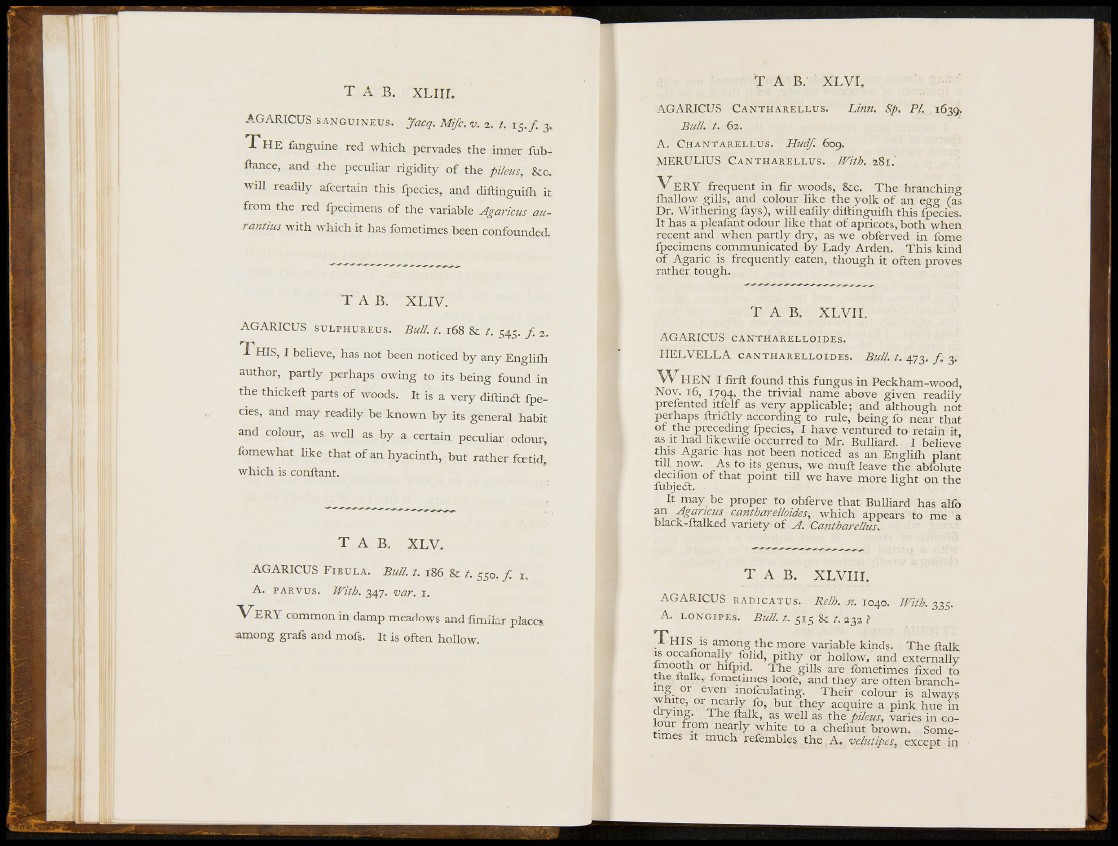
T A B . XLIII.
AGARICUS SANGUINEUS. Jacq. Mijc. v. 2. 1. 15./. 3,
T H E fangtiine red which pervades the inner fubftance,
and .the pecuhar rigiditj. of the pileus, &c.
will readily afcertain this fpecies, and diftinguifli it
from the red fpecimens of the variable Agaricus aurantius
with which it has fometimes been confounded.
T A B. XLIV.
AGARICUS SULPHUREUS. Bull. t. 168 & t. 545. / 2.
THIS, I believe, has not been noticed by any Engliih
author, partly perhaps owing to its being found in
the thickeft parts of woods. It is a very diftina fpecies,
and may readily be known by its general habit
and colour, as well as by a certain peculiar odour,
fomewhat like that of an hyacinth, but rather fcEtid,
which is conftant.
T A B . XLV.
AGARICUS FIBULA. Bull. t. 186 & t. 550. / i.
A. PARVUS. With. 347. var. i.
V E R Y common in damp meadows and fimilar places
among grafs and mofs. It is often hollow.
T A B . XL VI.
A G A R I C U S CANTHARELLUS. Linn. Sp. PL 1639.
Bull. t. 62.
A. CHANTARELLUS. Hudf. 6og.
M E R U L I U S CANTHARELLUS. With. 281.'
V E R Y frequent in fir woods, &c. The branching
fliallow gills, and colour like the yolk of an egg (as
Dr. Withering fays), will eafily diftinguiilr this fpecies.
It has a pleafant odour like that of apricots, both when
recent and when partly dry, as we obferved ixi fome
fpecimens communicated by Lady Arden. This kind
of Agaric is frequently eaten, though it often proves
rather tovigh.
T A B. XLVIL
AGARICUS CANTHARELLOIDES.
HELVELLA CANTHARELLOIDES. Bull. t. 473. /. 3.
W^HEN I firfl: found this fungus in Peckham-wood,
Nov. 16, 1794, the trivial name above given readily
prefented itfelf as very applicable; and although not
perhaps ftnaiy according to rule, being fo near that
of the preceding fpecies, I have ventured to retain it,
as It had hkewife occurred to Mr. Bulliard. I believe
this Agaric has not been noticed as an Engliih plant
till now. As to Its genus, we muft leave the abfolute
decifion of that point till we have more light on the
fubjea. ^
It may be proper to obferve that Bulliard has alfo
an ^gancus cantharelloides, which appears to me a
black-ftalked variety of A. Cantharellus.
T A B . XLVIII.
AGARICUS RADICATUS. Relh. n. 1040. With. 335.
A. LONGIPES. Bull. t. 515 & t. 232 ?
THIS is among the more variable kinds. The ftalk
IS occafionally folid, pithy or hollow, and externally
fmooth or hifpid. The gills are fometimes fixed to
me Italk, lometimes loofe, and they are often branchmg
or even mofculating. Their colour is always
but they acquire a pink hue in
drying. The italk, as well as the pileus, varies in colour
from nearly white to a chefnut brown. Sometimes
It much refembles the A. velutipes, except in